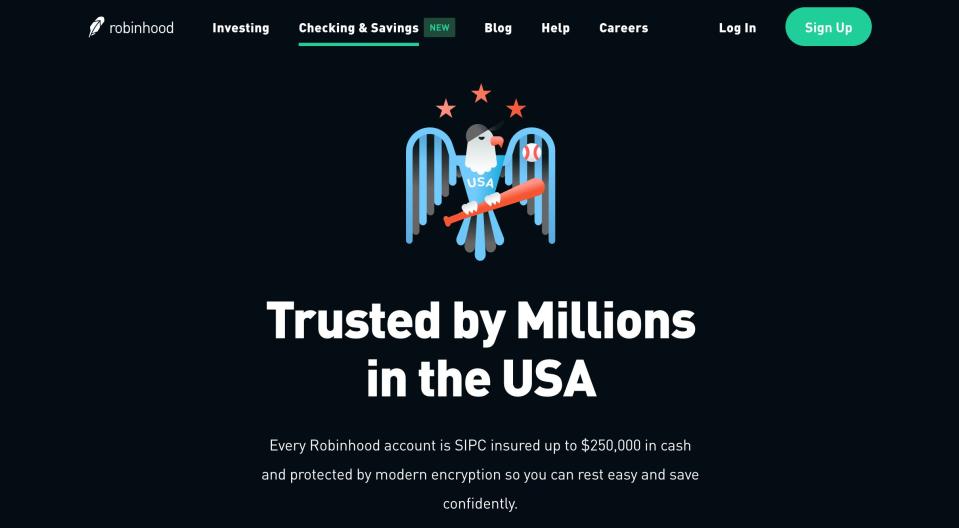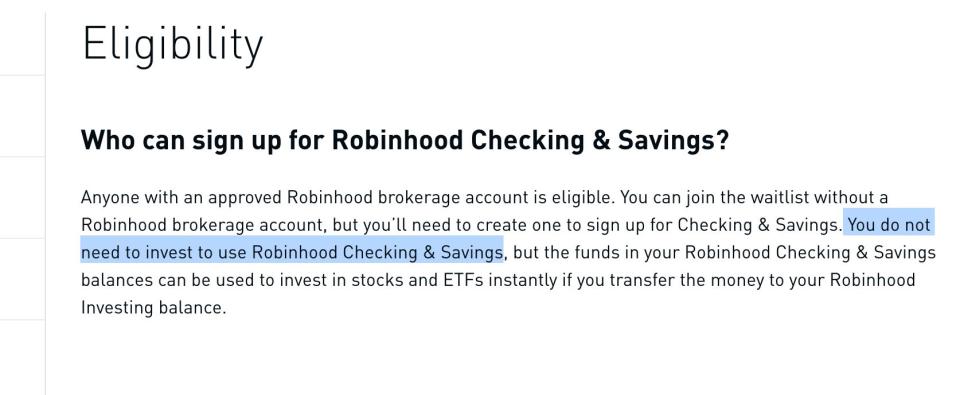Robinhood’s launch of checking accounts with 3% interest is a disaster

Update 12/17: Robinhood has released this blog post and has removed reference to “Checking & Savings” from its website, replacing it with “Cash Management.”
On Dec. 13, investing app Robinhood announced it will launch checking and savings accounts with a very generous 3% APY in 2019. By the next day, more than 589,000 people had signed up for the new product.
The best part of the new offering: you don’t need to invest in any of Robinhood’s products to open a checking and savings account, according to the company’s website.
Though checking-esque products from brokerages exist currently — you can get a debit card from Fidelity, or find high-yield cash and cash-like accounts from other fintech investing companies like Betterment — Robinhood’s option went viral because its number was wildly high.
The truth is, everyone should be earning 3% interest, but theres only one place you can get it @robinhoodapp #investor
— ashton kutcher (@aplusk) December 14, 2018
And perhaps also because, as its website says, “Every Robinhood account is SIPC insured up to $250,000 in cash.”
To put this in perspective, Betterment’s cash-like option (the account consists of Treasuries) pays 2.09% and does not claim to be insured by the Federal Deposit Insurance Corporation (FDIC). It is however protected by the Securities Investor Protection Corporation (SIPC), a federally-mandated, member-funded non-profit, though it does not trumpet this.
Soon after news spread of this sweet deal from Robinhood, the SIPC perked up. It didn’t know anything about this, and its president and CEO viewed Robinhood’s claims as deeply problematic. This rounds out a tough week for Robinhood, which had a trading outage that left some users furious.
“I first found out about this when I received media calls at 12:06 p.m. yesterday,” said Stephen P. Harbeck, president and CEO of SIPC. “I issued my view of what the law is: that SIPC only protects monies that are deposited for the purposes of purchasing securities.”
The main issue, Harbeck told Yahoo Finance, is that SIPC’s statutes mandate it to protect only a certain kind of account, which he interprets as not including checking and savings accounts.

“If you dig deep enough under help about how to make checking account, you need not invest to make a checking or savings account with them,” he said. This general purpose use would seem to violate the idea that the money is for the “purposes of purchasing securities.”
Harbeck asked his small staff of 40 whether they had spoken with Robinhood. A few had – but back in 2015. On this issue, Harbeck said nobody at SIPC had spoken with the company.
“I spoke to colleagues at trading and markets at the SEC and I assume they will be talking with Robinhood today,” he said. SIPC reports and is supervised by the SEC.
SIPC is waiting for the SEC for guidance, but Harbeck said he looked into some case law and found some interesting examples that could portend the future.
“One thing I do have is some case law going back to 1975, which says that SIPC does not protect lenders to brokers,” he said. “So if the relationship looks like you just deposited money there, you may be lending money to a brokerage firm – which is not protected.”

Harbeck added another concern. “Insurance doesn't appear in our name,” he said. “There is a reason for that. When people see that word they believe they can never lose money.”
The SIPC is not the FDIC, which does have insurance in the name, and protects consumers’ deposits up to $250,000 per account for banks.
Robinhood used the word “insure” rather than “protect,” which is the word that the SIPC uses.
As Charles Schwab’s website defines it: “Unlike the FDIC, SIPC does not provide blanket coverage. Instead, SIPC protects customers of SIPC-member broker-dealers if the firm fails financially. Coverage is up to $500,000 per customer for all accounts at the same institution, including a maximum of $250,000 for cash.”
Robinhood, which is a private company with no public financial information, has a business model that offers free brokerage trades, which is far less than the industry standard, between $5 to $20 per trade. With this new checking and savings product, more cash is likely to go out the door. Bloomberg reported that the company will be using U.S. short-term Treasuries, which pay around 2.45%, far below the 3% the company will be paying people who park their money.
That means Robinhood may be losing a substantial amount of money from each person who participates. Coupled with the lack of financial statements or regulatory filings for potential depositors to look at, and the expense to the bank, the principal protection may actually be an important factor for potential customers.
In October, Robinhood co-CEO Vlad Tenev told Yahoo Finance that it wanted to expand its offerings to be a “full service financial institution.”
Correction: This article has been updated to reflect that Betterment’s Smart Saver product is SIPC-insured.
-
Ethan Wolff-Mann is a writer at Yahoo Finance focusing on consumer issues, retail, personal finance, and more. Follow him on Twitter @ewolffmann.
Robinhood co-founder: 'We want to be a full-service institution'
Betterment to put idle money to work by automating cash management

